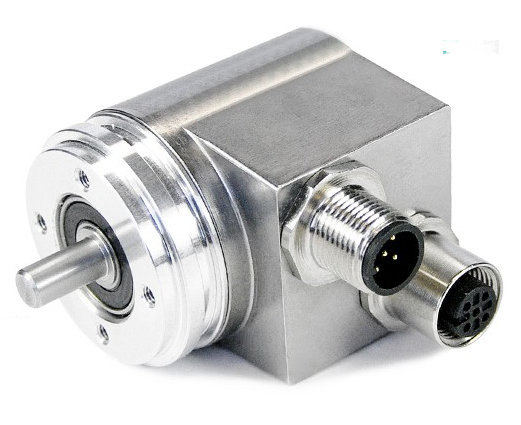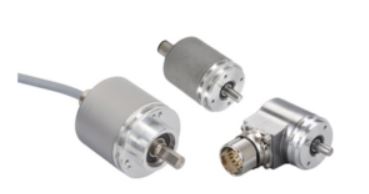Singleturn Encoders

Single-turn encoders provide a measurement range of 360 degrees (one turn). When the shaft of the encoder is turned by more than 360 degrees, output characteristics in subsequent turns will be equal to the first turn.
Examples: output@361 degrees = output@1 degree, output@720 degrees = output@360 degrees.
Multi-turn encoders

Multi-turn encoders provide a measurement range of more than 360 degrees by additionally measuring the number of revolutions. The output signal is based on the number of revolutions as well as on the shaft position within one turn.
Example: The output signal/value after 3.5 turns (starting from zero) will be 7 times higher than the output after the first half turn.
Single-turn Measurement Technology
The key element of the magnetic sensor is a Hall-Effect based sensor system that determines the angular position of the shaft according to the direction of a permanent magnets’ magnetic field. The permanent magnet is attached to the shaft, and its magnetic field penetrates the Hall sensor.
Multi-turn Measurement Technology
The Hall-Effect based sensor system is the single-turn stage of the absolute encoders. However, it does not enable the encoder to count revolutions if the external power supply is disconnected.
This problem is solved by POSITAL by means of an energy harvesting system based on the Wiegand Effect which requires no batteries or gears. Using batteries has inherent disadvantages; including a limited lifespan, considerable weight, and the fact that they contain harmful substances. Gear units also bring weaknesses of their own being large, complex, costly and vulnerable to shock and vibration.
Regardless of the rotational speed, even at near zero, the energy harvesting system generates short, powerful voltage pulses which supply sufficient power to the counting electronics in absolute encoders. Thus, the revolution counter can run independently of any external power supply. This principle, which has proven itself since 2005, enables maintenance-free reliable measurement of absolute position even in demanding environments over many years.
Signal Processing is the Key to High Performance
The technological leap that pushes POSITAL’s IXARC magnetic encoders to the performance level of optical systems is based on a new generation of these sensor systems. A custom Hall sensor in combination with complex signal processing by means of a powerful 32 bit microprocessor which results in a considerably better resolution and accuracy plus latency times of only a few microseconds.
POSITAL single-turn and multi-turn encoders are available with:
- Different Communication Interfaces
- Various Flange Designs: Clamp, Syncro, Square
- Multiple Flange (36, 42, 58mm) and Shaft Sizes (6, 10, … mm)
- Several Connection Options: Cable Exit, Connection Cap, Connector



